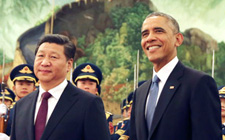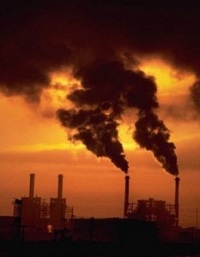Turn down the heat : confronting the new climate normal is a massive 320 page report prepared for the World Bank by the Potsdam Institute for Climate Impact Research and Climate Analytics, and hence highly authoritative. Continue reading Turn down the heat : confronting the new climate normal
Category Archives: Climate Change & Sustainability
Posts on aspects of climate science, climate action and climate policy & planning.
A failure of ambition: the UNEP Emissions Gap Report:
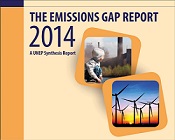
The United Nations Environment Programme (UNEP) has published its Emissions Gap Report 2014 a couple of weeks before the UN Conference on Climate Change in Lima, Peru. The latter is the annual UNFCCC Conference of Parties (COP), the penultimate one before the 2015 conference in Paris where, with a bit of luck, legally binding medium and long-term targets will be set for each country for emissions reduction. Each year since Copenhagen in 2009 the UNEP has reported on the gap between explicit pledges made by member states and what is required to have a likely (67%) chance of the planet staying within the 2°C guardrail. This is a necessary activity, because since Copenhagen each country determines its own targets within a framework of “common but differentiated responsibility”, which is a bunch of words that effectively allow each country to do as it pleases.
Someone needs to keep a tally as to what all this voluntary activity adds up to. UNEP had taken on that role.
The UNEP report takes note of and is broadly consistent with the IPCC Synthesis Report. Hence it accepts the IPCC ‘budget approach’ which states that we have already emitted 1,900 gigatonnes of carbon dioxide (Gt CO2) from an allowable budget of 2900 Gt since the dawn of the industrial era, leaving an estimated remaining budget of just 1,000 gigatonnes of carbon dioxide (Gt CO2). That’s roughly 20 years worth of emissions at the current rate.
Whereas the IPCC has given a range of scenarios, (scientists giving a range of options to policy makers) the UNEP has plotted just one which sees us peaking within about 10 years, halving CO2 emissions by 2050 and reaching net zero thereafter, they say between 2055 and 2070.
Net zero implies that some remaining CO2 emissions could be compensated by the same amount of carbon dioxide uptake, or ‘negative’ emissions, so long as the net input to the atmosphere due to human activity is zero, the report finds.
Because this scenario involves overshoot we will have to have net negative emissions during the last decades of the century. The less we act now the harder it gets later, as illustrated here:
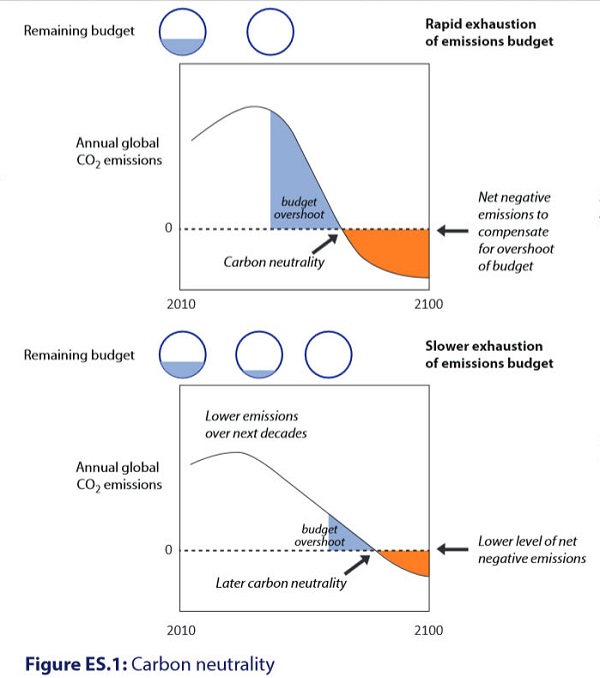
Hopefully this will sink into the brains of those attending the Lima conference, and more importantly the brains of their masters back home.
UNEP have done the sums and find that emissions in 2020 should not be higher than 44Gt CO2e to have a 67% chance of staying within
the 2°C target. If countries honour their current pledges we are heading for 52–54 Gt CO2e in 2020, leaving a gap of 8–10 Gt CO2e.
UNEP then looked at whether countries were on track to honour their pledges.
After reviewing available evidence from the G20 (with the EU 28 taken as a group) it appears that five parties to the United Nations Framework Convention on Climate Change – Brazil, China, the EU28, India and the Russian Federation – are on track to meet their pledges. Four parties – Australia, Canada, Mexico and the USA – are likely to require further action and/or purchased offsets to meet their pledges, according to government and independent estimates of projected national emissions in 2020. Conclusions are not drawn for Japan, the Republic of Korea, Indonesia and South Africa because of various uncertainties, nor for Argentina, Turkey and Saudi Arabia because they have not proposed pledges.
In 2010 we were at 49Gt CO2e; in 2020 we are likely to be at 55 Gt CO2e. The broad situation out to 2030 is represented as follows:
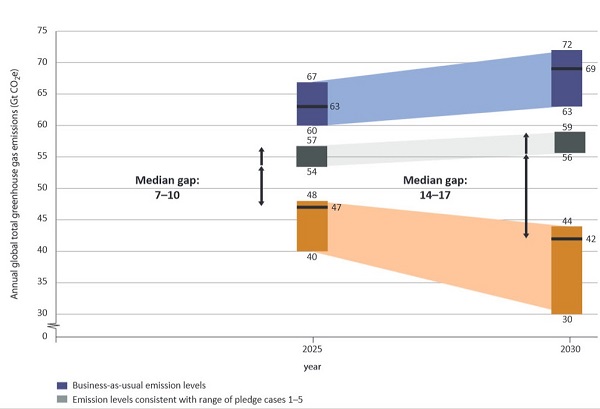
I take it that our current form will get us to 56 to 59 Gt CO2e (grey), whereas we should at the very least be at 42 Gt CO2e (in the orange zone).
The gap is still widening.
There are several comments that need to be made.
First, the UNEP calculations would not have taken on board the China-US agreement. As stated in that post, Climate Interactive worked out that if other countries matched the US-China effort the following stabilisation scenario would ensue:
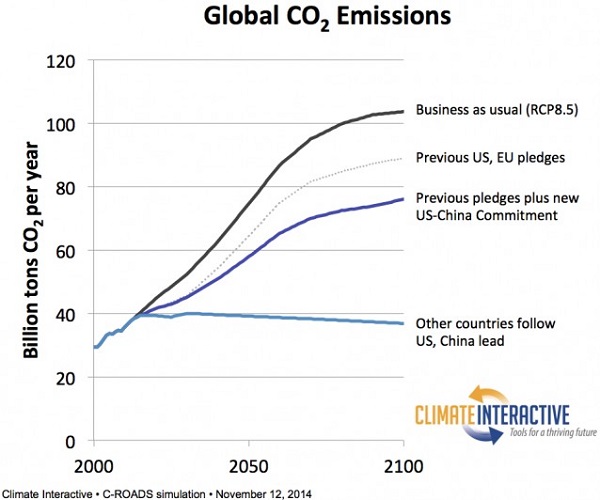
For the first time we have a prospect of peaking emissions, but this does not come within a bulls roar of zero emissions in the second half of this century. The current level of ambition is lamentably lacking.
Secondly, and admirably, the UNEP report takes into account all greenhouse gases from all sources, calculated in terms of CO2 equivalent. Too often scientific reporting is limited to fossil fuel emissions.
Thirdly, the report is conceived within a framework that is irresponsible, bordering insane. A 67% chance of not breaching the 2°C guardrail represents lousy odds when we are dealing with the viability of major ecosystems on the planet and the future of civilisation.
The 2°C guardrail itself is now clearly inappropriate, when, for example as I explained in this post and elsewhere that preserving more than 10% of coral reefs worldwide in 2100 would require limiting warming to below 1.5°C.
The World Bank report Turn down the heat contains examples like this:
In Brazil, at 2°C warming, crop yields could decrease by up to 70 percent for soybean and up to 50 percent for wheat.
The scientists from the Potsdam Institute for Climate Impact Research and Climate Analytics who put that report together for the World Bank are telling it like it is. Sadly the international array of scientists and others involved in the UNEP report (plenty of Germans but none I can see from Potsdam) are making concessions to what they think will be politically acceptable and doable, as, unfortunately, does the IPCC report.
The stakes are too high for such dissembling diplomacy!
Update: Len @ 1 asked:
It would be nice to at least know what level of action is needed to reach a 95% level surety. Is this stated anywhere?
Back in 2008 James Hansen told us that we had already overshot and that in the first instance we should get concentration levels down to 350 CO2e. Hower, he seems to be about a decade ahead of the bulk of the scientific/political community concerned with climate change. The 2°C guardrail had been invented by the Germans in the 1990s and was accepted by the UNFCCC process as a desirable aim in Copenhagen in 2009. Since then it has become the ‘widely accepted standard’ we should aim at. As such it provides the framework within most climate mitigation scientists work.
The IPCC Fifth Assessment report (AR5) (my post on the Synthesis Report here – see second table) did not look at stabilisation scenarios aiming at less than 450 ppm CO2e. They have a column for <430 but didn't fill it in, because of a lack of studies in the scientific record. The IPCC relies on studies in the scientific literature, with a cutoff of about December 2012, and insufficient studies were available for them to fill in the numbers. So the failure is with the scientific community, sadly. I can give you two pointers. The first is this wondrous graph which I first picked up in The Climate Authority Review of targets:
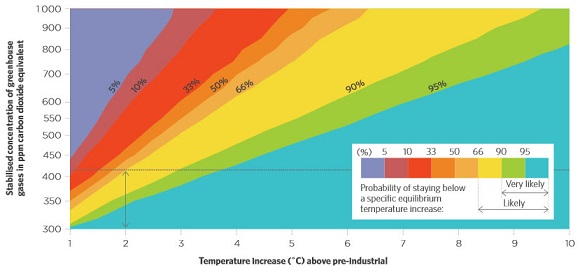
The graph has Malte Meinshausen’s name on it. He was at the time at the Potsdam Institute, I believe he is now at the University of Melbourne. His work is excellent.
From the graph you can see that 350 ppm will only get you about a 95% chance of staying below 2.5°C, not 2°C.
If you want a 1.5°C climate you need about 320 ppm. We are currently at 480 ppm CO2e.
It is notable that David Spratt and Philip Sutton wrote in 2008 that we should be aiming at 320 ppm. Spratt blogs at Climate Code Red, where under Publications you will find a book by the same name which was originally published online in 2008 as The Big Melt written in response to the astonishing Arctic melting in 2007, since easily surpassed in 2012. Spratt is a science writer rather than a scientist, and consistently publishes critiques of the mainstream approach, as I picked up, for example in The game is up, where he says:
We have to come to terms with two key facts: practically speaking, there is no longer a “carbon budget” for burning fossil fuels while still achieving a two-degree Celsius (2°C) future; and the 2°C cap is now known to be dangerously too high.
He concludes that there is no longer a non-radical option, only one path remains viable: the emergency ‘war economy’ mode.
Climate Code Red identifies practical strategies we need to adopt.
The Australian group Beyond Zero Emissions consistently publish material on rapid decarbonistaion. My mate John Davidson has investigated them more than I have and regards them as sound. I hope to post on one of their reports soon.
Elsewhere Kevin Anderson from the UK is worth keeping an eye on. See his personal site and Real clothes for the emperor.
Professor John Wiseman, Deputy Director of the Melbourne Sustainable Society Institute at the University of Melbourne looked at the shape of climate policy for the future for the Centre for Policy Development. See Climate change: reconnecting politics with reality. He has an appropriate sense of urgency and sets out the specific strategies we need to adopt in Australia for rapid decarbonisation. He, for example, sees the need for 100% renewables in 10 years.
People like Spratt, Anderson, Wiseman and BZE are all looking for “the achievement of emission reductions at the necessary scale and speed [which] will require transformational rather than incremental change”. The war analogy is not inappropriate. Abbott would have us fiddle while Rome burns. His approach is essentially one of tokenism. You run a climate mitigation program off to one side in order to have one on your books, at the least expense you can get away with. It’s essentially a sop to the electorate which doesn’t interrupt your central vision of the generation of wealth based centrally on the fossil fuel industry.
This is delusional – see The folly of Galilee basin coal.
Climate clippings 115
1. Australia’s coal and gas exports are being left stranded
Just four countries account for 80% of Australia’s fossil fuel exports – China, Japan, Korea and India.
China is on the verge of “peak coal”, rebalancing the economy away from energy intensive industry and introducing a national emissions trading scheme.
Japan is on an energy efficiency drive to reduce its fuel import bill.
Korea has introduced a tax on coal of AU$18 per tonne and is finalising an emissions trading scheme.
India has doubled its tax on coal which funds renewable energy projects and has signalled its intention to stop importing coal within 2-3 years.
Official forecasts are in denial.
2. Are Australian and US climate targets the same?
Environment minister Greg Hunt, Radio National, November 17:
If you use the full Kyoto period — 1990 to 2020 — the US is minus 5% and Australia is almost exactly the same.
Joe Hockey made a similar statement that “If you compare apples with apples, the American position and our position on reductions are effectively the same.”
The comparisons are complex, because the starting and finishing dates are different, so are the population increases. Moreover Australia has forestry and tree clearing in the mix.
Malte Meinshausen and Anita Talberg make the necessary adjustments and find:
An apples-with-apples comparison shows that Australia lags far behind the United States in efforts to reduce greenhouse gas emissions from its energy, transport and industrial sectors.
To match US efforts, Australia would have to increase its 2020 ambitions from the current 5% below 2000 to 21% or even 29%, depending on whether different population growth is taken into account, or not.
In short, they lie!
3. The genius of Tony Abbott’s stance on climate
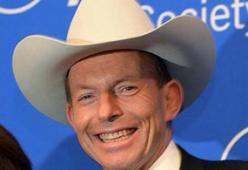
At New Matilda Tom Allen comments on Tom Switzer’s claim the Abbott is a climate change genius. Switzer is a climate change denialist, so we won’t bother with that! Allen finds Abbott has proved one thing – that a carbon tax works!
Abbott
will be remembered as the Prime Minister who proved that the carbon tax worked. After it was introduced, Australia’s carbon dioxide emissions fell, the economy continued to grow and the sky remained in place.
When Abbott repealed it and the country’s emissions began to rise again, using Australia as a vast laboratory, Abbott confirmed it: carbon taxes work.
4. Record growth in electricity sector emissions
Abbott’s genius is demonstrated by this graph of emissions change from electricity production:
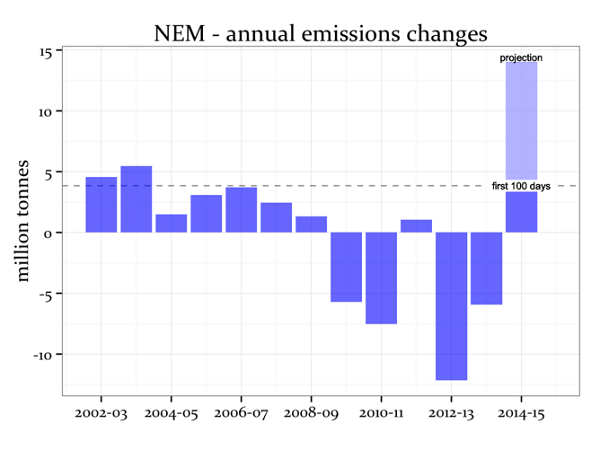
The reductions started well before the carbon ‘tax’, but whatever the reason Abbott seems to have made a difference.
WORST. PRIME MINISTER. EVER!!
As Tom Allen said, it’s nothing personal.
The worst things about him are his policies, and his stance on climate change is worst of all.
5. Record-breaking ocean temperatures
The world’s oceans are the hottest they’ve ever been in the modern record, especially in the northern Pacific.
In July this year, ocean surfaces were 0.55 °C above the average since 1890, just beating the previous record of 0.51 °C in 1998. In the North Pacific, the temperatures were about 0.8 °C above average, which is 0.25 °C warmer than the 1998 peak.
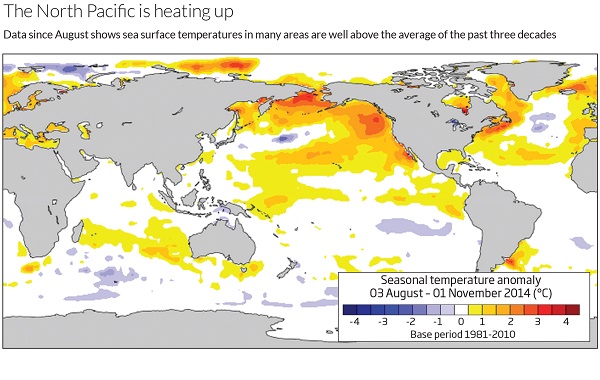
No explanation is given as to why this pattern has emerged. However, it does seem to be disrupting the development of an El Niño. Small mercy, because the northern Pacific warming has effects similar to an El Niño:
This includes more hurricanes in the Pacific, as well as more storms curling over into mainland US. Meanwhile, there have been fewer hurricanes in the Atlantic, just as happens during El Niño. Elsewhere, dry conditions have occurred across Australia, and the Indian monsoon was delayed – effects all arising from warm oceans, despite the lack of an El Nino event.
6. Turn down the heat : confronting the new climate normal
This is volume 2 of 2 of a report prepared for the World Bank by the Potsdam Institute for Climate Impact Research and Climate Analytics, and hence highly authoritative. The lead author was Hans Joachim Schellnhuber of the Potsdam Institute.
It’s a massive 320 page report. This is from the Foreword:
There is growing evidence that warming close to 1.5°C above pre-industrial levels is locked-in to the Earth’s atmospheric system due to past and predicted emissions of greenhouse gases, and climate change impacts such as extreme heat events may now be unavoidable.
As the planet warms, climatic conditions, heat and other weather extremes which occur once in hundreds of years, if ever, and considered highly unusual or unprecedented today would become the “new climate normal” as we approach 4°C—a frightening world of increased risks and global instability.
The consequences for development would be severe as crop yields decline, water resources change, diseases move into new ranges, and sea levels rise. Ending poverty, increasing global prosperity and reducing global inequality, already difficult, will be much harder with 2°C warming, but at 4°C there is serious doubt whether these goals can be achieved at all.
That’s about as far as I could get tonight. Climate Progress has a post.
What do scientists think about the Great Barrier Reef?
That’s the question Leigh Sales should have been asking rather than playing prompt to Julie Bishop’s spin on the 7.30 Report.
I’ve been citing a 2011 study by K. Frieler et al which found that:
preserving more than 10 per cent of coral reefs worldwide would require limiting warming to below +1.5°C (atmosphere–ocean general circulation models (AOGCMs) range: 1.3–1.8°C) relative to pre-industrial levels.
What President Obama and the Chinese are doing is not nearly enough to save the Great Barrier Reef, and there’s a fair chance that Obama knows it.
The ABC news bulletins have simply been repeating the Government lines without asking Opposition spokespeople, let alone scientists. The Guardian did better:
Bishop said on Friday the government did not believe the reef was in danger – a comment that contradicts the scientific consensus that it is.
The 2014 outlook report from the Great Barrier Reef Marine Park Authority said: “Climate change remains the most serious threat to the Great Barrier Reef. It is already affecting the reef and is likely to have far-reaching consequences in the decades to come.”
Radio National’s PM program in a segment not picked up by their news outlets interviewed Dr Jon Brodie from James Cook University who was the lead author of a 2008 scientific report for the Queensland Government on water quality issues affecting the Great Barrier Reef, and last year completed a Scientific Consensus Statement based on the views of more than 50 scientists and policy experts. He cites the Australian Government’s own outlook report 2014 linked above which:
says very clearly that the reef is in poor condition and continuing to deteriorate, and that major actions are needed to stop that deterioration.
Bishop says that the people who look after the reef are following the world’s best practice. Brodie says that’s irrelevant because what they are doing is ineffective:
The reef’s lost half its coral, it’s lost most of its dugong, seagrass is in poor condition. Most of the major indicators of the reef are in a serious state and serious state of decline. And hence, whatever management we are doing now, whatever standard it is, it’s not enough.
The Queensland and Federal governments have come out with a draft Reef 2050 Sustainability Plan to address the reef’s decline but Brodie describes it as “very weak”.
The bottom line?
the Government’s own report on the reef, very clearly says that climate change is a major issue for the reef. And if we don’t do anything about it, somebody doesn’t do something about it, then there’s not really a lot of hope to have the reef restored to its, you know, good value.
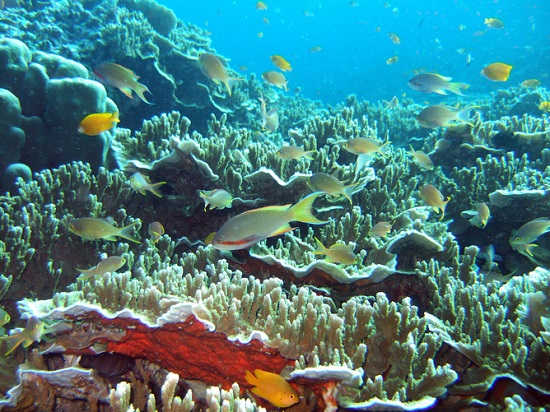
The SMH asked several scientists including Brodie, Dr Ove Hoegh-Guldberg, Director of the Global Change Institute at The University of Queensland and Dr Charlie Veron, a former chief scientist at the Australian Institute of Marine Science.
Ove Hoegh-Guldberg was involved in the Frieler research cited above and stressed the dangers of ocean acidification. In 2012 he wrote an article for The Conversation pointing out the inappropriateness of the 2°C guardrail for preserving coral reefs.
Veron was blunt:
“In the long term, that is the whole of this century, we are going to have the Great Barrier Reef slaughtered,” Dr Veron, a world authority who has scientifically named about one-quarter of all known corals, said.
“There’s no doubt about that at all, if carbon-dioxide emissions keep on tracking as they are.”
Currently UNESCO is undertaking a review of the Great Barrier Reef’s World Heritage status, due for completion by mid-2015.
Both Brodie and Veron see the Queensland and Australian governments in a frenzy to head off an ‘endangered’ listing. It was pointed out on the ABC Insiders program that such a listing would inhibit the financing of planned developments.
Obama is right to worry what his granddaughters will see if they come to visit. It’s possible there will still be something worth crossing the Pacific for. Chances are, however, that his great granddaughters will stay at home.
It’s all very simple really – Government spin versus very real concern by scientists, a threat to UNESCO World Heritage listing with flow-on effects on development, and international goals for a 2°C guardrail which will see the reef destroyed.
Climate clippings 114
1. Ocean acidification charted
Apparently there has been no baseline data for ocean acidification, which varies around the world. Now a database of the current state of the ocean has been compiled. Here is a map showing the rough state of play:
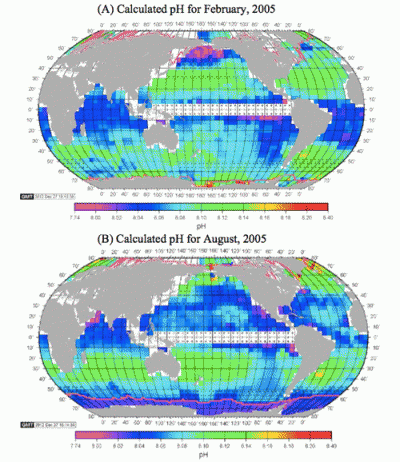
The current rate of acidification for the ocean is the greatest seen in the past 300 million years. 25% of co2 emitted ends up in the ocean.
This article offers some hope that some species may adapt.
2. Warmest October
NASA has October as the warmest since 1880 along with 2005. The Japanese Meteorological Agency has it as the warmest ever:
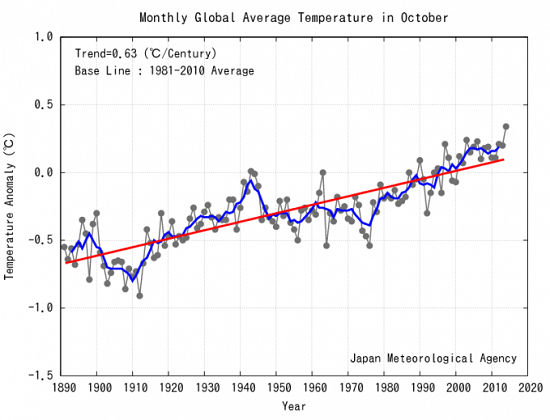
No warming pause there!
So far an El Niño still has not developed, which would make things warmer.
3. Climate Council report fingers us
The Climate Council has published a new report Lagging Behind: Australia and the Global Response to Climate Change. The key findings are:
- China and the US have firmly moved from laggards to global leaders on climate change.
- In the last five years most countries around the world have accelerated action on climate change as the consequences have become more and more clear.
- Australia, a crucial player in global climate action, moves from leader to laggard.
- Global action must accelerate to protect Australia and the world from the consequences of a changing climate, sea level rise and more frequent and intense extreme weather.
Now, 39 countries and over 20 sub-national jurisdictions are putting a price on carbon. China has the world’s second largest carbon market with 250 million people covered. In the US 10 states have carbon markets, covering 79 million people.
Germany has decoupled growth from carbon pollution. Since 1990 GDP has increased 37% while emissions have fallen 25%.
According to the IEA and the OECD for every $1 spent to support renewable energy, another $6 is spent on fossil fuel subsidies, but investment in renewable energy at US$192 billion now exceeds that in fossil fuel energy at US$102 billion.
Australia is the 15th largest emitter out of 186 countries. We emit roughly the same as France, Italy and Turkey, each with three times the population.
Here’s the world wide solar growth:
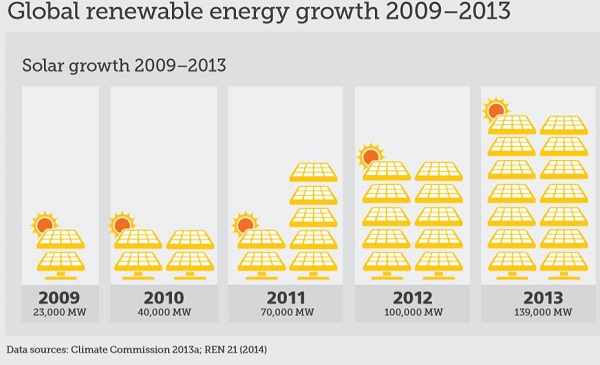
Our record on large scale renewables:
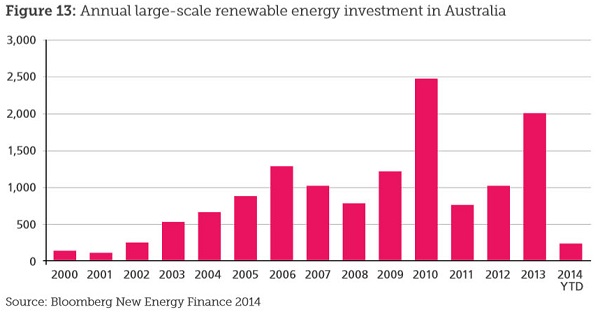
Time to get on our bike!
4. Climate Council on renewables
The Climate Council report finds that around the world important initiatives on renewables are often taken at the sub-national level. In Australia:
- South Australia is striding forward leading the Australian States on renewable energy.
- Victoria and NSW have moved from leaders to laggards in Australia’s renewable energy race.
- Australia has substantial opportunities for renewable energy. A lack of clear federal policy has led to a drop in renewable energy investment.
Only SA and the ACT have renewable energy targets – SA 50% of electricity by 2025, the ACT 90% by 2020. The current state of play is:
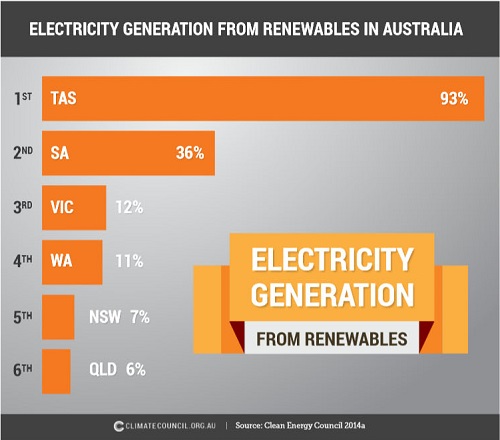
SA narrowly pips QLD in terms of percentage of dwellings with solar PV:

Both have roughly a quarter.
The potential for renewables in Australia is huge – some 500 times current electricity generation.
Australia produces per capita 23.96 tCO2e as against an OECD average of 12.47. As I said, time to get on our bike!
5. China caps coal use by 2020
The Chinese government announced Wednesday it would cap coal use by 2020. The Chinese State Council, or cabinet, said the peak would be 4.2 billion tonnes, a one-sixth increase over current consumption.
This is a staggering reversal of Chinese energy policy, which for two decades has been centered around building a coal plant or more a week. Now they’ll be building the equivalent in carbon-free power every week for decades, while the construction rate of new coal plants decelerates like a crash-test dummy.
The 2020 coal peak utterly refutes the GOP claim that China’s recent climate pledge “requires the Chinese to do nothing at all for 16 years.” Indeed, independent analyses make clear a 2020 coal peak announcement was the inevitable outcome of China’s game-changing climate deal deal with the U.S. last week, where China agreed to peak its total carbon pollution emissions in 2030 — or earlier.
6. Australia a pariah
Giles Parkinson thinks other nations are deliberately trying to embarrass Australia on climate change. Certainly Obama’s remarks can be interpreted that way. Then he (Giles) really gets stuck in:
We are, quite possibly, witnessing the most incompetent and ideologically blind government ever to hold power in Canberra. It’s effectively the Tea Party of Australia, pretending to be something else.
G20 goodness
Overall when I think about the Brisbane G20 I’ll think about Putin not being shirt-fronted and leaving the instant the conference was over, about president Obama putting climate change front and centre in peoples minds, deserted streets and empty cafes, masses of coppers, 6000 of them, and traffic gridlock from here to the Gold Coast as people took advantage of the long weekend.
Yes, Brisbane welcomed the pollies and thousands of journalists by getting the hell out of here.
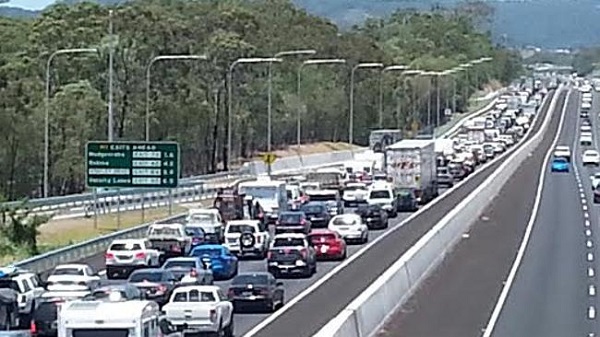
As to Abbott’s role in the G20, Paul Syvret in the Courier Mail summed it up perfectly (thankyou John D!):
TAKE a bow ’Straya. You showed the world, when given the opportunity to shine on a global stage of grand ideas, just how small-minded and insular we can be.
Sure, we hosted a meeting of G20 leaders that went off without a logistic hitch or any ugly civil unrest or security incidents. Well done us.
The vision and inspirational leadership side of the equation though left a bit to be desired.
Less than a week after the United States and China announced a landmark agreement to tackle climate change, Australian Prime Minister Tony Abbott opened proceedings at the G20 summit by boasting how Australia had abandoned its carbon-pricing scheme.
He also, literally, thanked God that we have stopped the “illegal boats” – in the company of people like Italian Prime Minister Matteo Renzi, whose navy earlier this year rescued more than 3500 seaborne asylum seekers in one 48-hour period.
Then for good measure, he moaned to the world’s most-powerful leaders about his failure to get a $7 Medicare co-payment through the Senate; parish pump pissantery in front of the likes of US President Barack Obama, whose administration went to the brink of international debt default thanks to a gridlocked Congress.
A columnist for the LA Times described it as “an awkward, pimply youth moment so embarrassing that it does sting”.
Australia, she wrote, is “the adolescent country. The bit player. The shrimp of the schoolyard.”
“The Group of 20 summit could have been Australia’s moment, signalling its arrival as a global player … but in all, the summit had Australians cringing more than cheering.”
Bill Shorten dubbed Abbott as “weird and graceless”.
Compare Barack Obama’s visionary eloquence, laying down the gauntlet on climate change and announcing a US$3 billion contribution to the Green Climate Fund. His speech if you missed it is here.
Ironically there was a point to Abbott’s whingeing about the $7 Medicare co-payment. If you ask Joe Hockey, he’ll tell you G20 was about growth, 2 trillion dollars of it, in 862 concrete proposals put forward by the G20 countries. Apparently Australia’s bright ideas for growth included wrecking Medicare and ripping 20% of funding out of our universities. Fair dinkum! Makes you wonder about the other 860 ideas!
Another point is that the ideas for growth were supposed to be ideas that the governments would not otherwise have done. However, I understand the gun went off in February in preparation for the G20 finance ministers meeting in Cairns in September. Are we really to believe that the Abbott government would have left Medicare and universities alone in the 2014 budget, but for G20?
It must be said that the Brisbane G20 was well organised from every viewpoint. The G20 Leaders’ Communiqué, 21 points in three pages of text, plus lists of supporting documents, is mercifully succinct. Of course it was written and circulated beforehand. Climate change was always going to be there (para 19) because a Climate Finance Study Group had been set up at an earlier meeting.
By the way the Abbott government does not support the Green Climate Fund, designed to assist developing countries, and apparently won’t contribute. Our share, pro rata, should be a mere $200,000 or so.
The G20 spawns a large number of sub-groups. Apart from the finance ministers and central bankers, trade ministers have met and now energy ministers will follow suit. There is a Financial Stability Board and a G20 Food Security and Nutrition Framework, for example. As a decision of this meeting a Global Infrastructure Hub will be established in Sydney to facilitate infrastructure planning.
Around the G20 sit an alphabet soup of meetings hoping to influence the G20. The B20 meeting of business leaders is inside the tent in formal collaboration with the G20. By contrast an L20 group, I gather of labour unions, is ignored. A ‘women in leadership’ group was luckier. The G20 responded by (para 9) agreeing to a goal of
reducing the gap in participation rates between men and women in our countries by 25 per cent by 2025, taking into account national circumstances, to bring more than 100 million women into the labour force, significantly increase global growth and reduce poverty and inequality.
There was also a T20 organised by think tanks. In addition there was a Global Cafe, I think organised by the Brisbane City Council, which brought together “futurists and thought leasers”.
There were plenty of protests. For example, refugee advocates released paper boats on the Brisbane River and were ignored. I think Turkey, the next host, is going to put refugees on the agenda.
Aborigines shouted angry words and burnt effigies of Noel Pearson, Marcia Langton and Warren Mundine.
The police set up formal lines of communication with groups planning to protest and facilitated how they might do it. As a result there were only 14 arrests, compared I believe with 1300 in Toronto. It was unusual to see protesters praised by police on the telly. There was no property damage.
Those who thought that Vladimir Putin was comprehensively roasted by other leaders missed an informal meeting of BRICS (Brazil, Russia, India, China, South Africa) where Putin was supported and the sanctions declared illegal.
On climate change, Laura Tingle reckoned Obama delivered Abbott a lesson in power. Within the meeting according to The Age Abbott carried on like a pork chop, giving an impassioned defence of coal and opposing the goal of eliminating fossil fuel subsidies.
Enough said!
Elsewhere John Quiggin thinks hosting the G20 did nothing for Brisbane and was a waste of money. The notion that events like this “put Brisbane on the map” is silly.
I dunno! Perhaps Angela Merkel taking selfies in a Caxton Street pub will bring her many Tweet followers flocking to Brisbane!
A game changer? The US-China climate deal
Mother Jones thinks the deal is a game changer, so does Joe Romm at Climate Progress. Climate scientists what agree with some cautions, including the big one that it’s not nearly enough.
In the broad, China has agreed to peak emissions by 2030, the US will reduce emissions by 26 to 28% by 2025, relative to 2005.
Yet China will still be getting 80% of its power from fossil fuels in 2030.
They said China would never do a deal of significance, and the US could not make significant reductions politically while China did nothing. That’s why the deal is a game changer.
Now Republicans are saying that China is doing nothing for 16 years. That’s not true. China will install 800-1,000 gigawatts of nuclear, wind, solar and other zero emission generation capacity by 2030.
Joe Hockey implied that Obama will not deliver, because of an unfriendly Congress. Obama said on Sunday specifically that he is not relying on Congress for anything – he’ll do it without their help. Republicans are freaking out and will no doubt destroy the deal if they reclaim the presidency.
Given the unhelpfulness of Congress Obama’s plan is surprisingly ambitious, roughly doubling the pace of reductions:
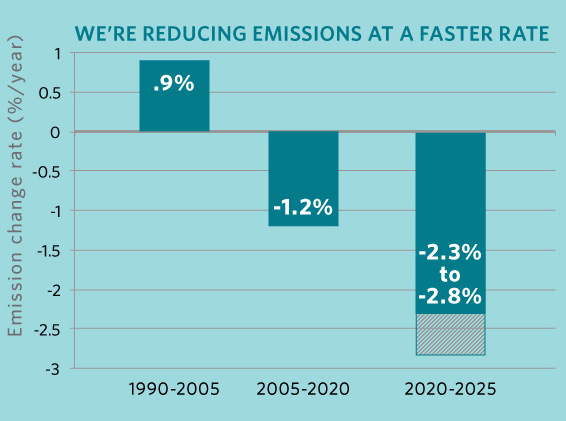
The overall impact is portrayed by this graph from Climate Interactive:

That would see emissions in 2100 roughly the same as they are now. According to the recent IPCC Synthesis Report most of the stabilisation scenarios you’d want to follow see zero emissions some time before 2100. You can get a rough idea of what’s required from this graph by Prof Hans Joachim Schellnhuber:
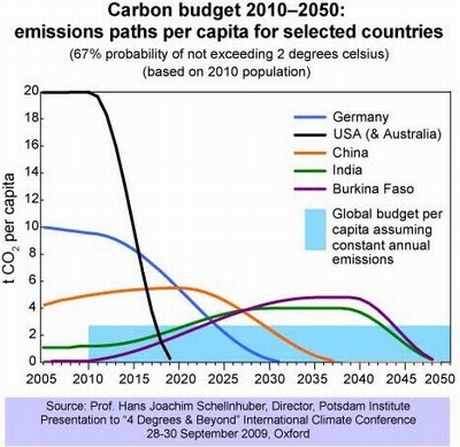
That is for a 67% chance of not exceeding 2°C.
With emissions trading that would be modified thus:
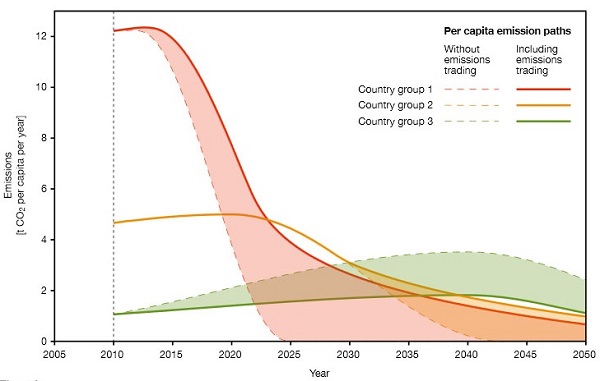
I would assume that China is a Group 2 country in this scenario.
At a rough guess, then, I suspect that China and the US are doing no more than half what they really should, if we assume that 2°C is OK, which I don’t.
Mother Jones lists some of the detailed items covered in the agreement:
- Expanding funding for clean energy technology research at the US-China Clean Energy Research Center, a think tank Obama created in 2009 with Xi’s predecessor Hu Jintao.
- Launching a large-scale pilot project in China to study carbon capture and sequestration.
- A push to further limit the use of hydroflourocarbons, a potent greenhouse gas found in refrigerants.
- A federal framework for cities in both countries to share experiences and best practices for low-carbon economic growth and adaptation to the impacts of climate change at the municipal level.
- A call to boost trade in “green” goods, including energy efficiency technology and resilient infrastructure, kicked off by a tour of China next spring by Commerce Secretary Penny Pritzker and Energy Secretary Ernest Moniz.
All good stuff. One valid criticism is that the agreement neglects the issue of adaptation, necessary because under the implied scenario warming will continue.
Our government has chosen to be a follower rather than a leader. It is now time to follow. But in doing so they should take a look at Prof Schellnhuber’s graphs to understand their true responsibility – and why buying carbon credits offshore is not such a bad idea.
To take the politics out of the issue they could even flick it to The Climate Change Authority. That’s what it was set up for.
Climate clippings 113
1. The Amazon is drying
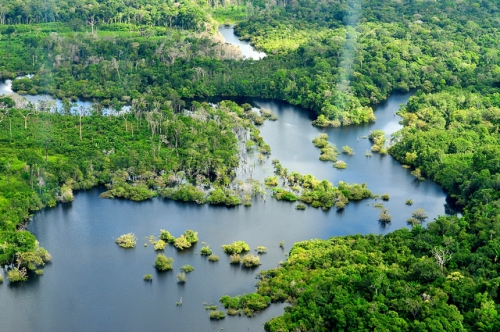
Since 2000, rainfall has decreased by up to 25% across a vast swath of the southeastern Amazon, according to a new satellite analysis.
The area of concern is 12 times the size of California. The Amazon overall takes up 25% of the global carbon cycle that vegetation is responsible for, so it’s a significant carbon sink. With further drying the Amazon could become a carbon source rather than a sink.
Causes are not clear, but it’s possible that rainfall patterns have moved further north with global warming.
In related news, the re-election of Dilma Rousseff as president is seen as a significant negative for the environment in Brazil.
2. Great Barrier Reef protection plan ‘ignores the threat of climate change’
In its formal response to the Reef 2050 long-term sustainability plan, which was drawn up by the Australian and Queensland governments, the Australian Academy of Science states the strategy is “inadequate to achieve the goal of restoring or even maintaining the diminished outstanding universal value of the reef.”
There is “no adequate recognition” in the 2050 plan of the importance of curbing greenhouse gases.
Professor Terry Hughes, director of the Australian Research Council Center of Excellence for Coral Reef Studies and an academy fellow, said the plan was focused on the sustainable development of four “mega ports” adjacent to the reef, rather than conservation of the reef itself.
The Great Barrier Reef has lost around half its coral cover in the past 30 years. The question now is whether UNESCO will list the GBR as endangered.
3. Limiting global warming to 2°C is unlikely to save most coral reefs
In this recent post I mentioned that “preserving more than 10 per cent of coral reefs worldwide would require limiting warming to below +1.5°C (atmosphere–ocean general circulation models (AOGCMs) range: 1.3–1.8°C) relative to pre-industrial levels”. Following the links, the paper by K. Frieler at al is here.
It annoys me that the dangers to reefs from temperature change and ocean acidification are almost never mentioned, even by greenies. Opposition pollies should be speaking up too! That paper has been around since 2011.
4. Carbon capture and storage research budget slashed
The government has cut almost half a billion dollars from research into carbon capture and storage – which the Intergovernmental Panel on Climate Change (IPCC) deems crucial for continued use of coal – despite the prime minister insisting coal is the “foundation of our prosperity”.
In the budget the government cut $459.3m over three years from its carbon capture and storage flagship program, leaving $191.7m to continue existing projects for the next seven years. The program had already been cut by the previous Labor government and much of the funding remained unallocated.
John Connor, the chief executive of the Climate Institute, said CCS “has to be one of the clean energy options available because all the modelling says that to avoid temperature rises of more than two degrees, we have to take carbon dioxide out of the atmosphere”.
The first full-scale CCS power plant, the Boundary Dam Carbon Capture and Storage Project in Canada, opened last month.
5. Poland rejects zero coal by 2100
Poland and a bunch of eastern Europe countries “have categorically rejected the target put forward by the world’s top climate scientists to reduce carbon emissions to zero by 2100 to avoid dangerous global warming…”
You might recall that when Poland hosted the UNFCCC Conference of Parties in 2013 it was positively promoting coal.
The EU has not yet apportioned the effort between countries in planning to meet recently announced emissions reduction targets. The fun is about to begin!
6. Roof top solar in San Francisco
New regulations in San Francisco will require new buildings to have roof top solar or gardens or both.
7. Tesla solar supercharging network
Tesla is rolling out a solar supercharging network for electric vehicles throughout the world eventually. Soon they will make a beginning in Australia.
The superchargers provide half a full charge in as little as 20 minutes, and are usually located near amenities like roadside restaurants, cafes, and shopping centers. Usually they have between 4 and 10 stalls.
The $5 billion “giagfactory” to be built in Nevada will generate more than 100% of its electricity needs with wind and solar.
The world is changing!
8. News of energy storage is a big, big deal
So says Sophie Vorrath at RenewEconomy:
The big announcements keep coming from the energy storage sector, with news this week that US behind-the-meter startup, Stem, has been tapped to provide 85MW of distributed energy storage to households in the West Los Angeles Basin.
The deal, a multi-year agreement awarded to Stem by Southern California Edison (SCE), marks America’s largest distributed energy storage project to date, and the first time energy storage has competed with traditional energy sources like natural gas at this scale.
For its part of the deal, Stem will deploy its advanced, behind-the-meter energy storage technology at customer locations in the Western LA Basin to act as dispatchable capacity to enhance the local reliability of the region.
In other words, using the combination of storage and its proprietary software platform, Stem will allow customers to monitor and manage energy use, which in turn will provide additional capacity to SCE.
9. Billboard banned
You may have heard that Brisbane Airport banned a billboard suggesting to incoming G20 delegates that climate change should be on their agenda. Apparently the billboard was “too political”.

Getup and a bunch of other NGOs are campaigning to have the decision reversed.
The billboard was based on the experience of South Australian grape grower David Bruer, a farmer from South Australia who lost $25,000 worth of grapes in one day when temperatures soared to 45°C last year.
IPCC Synthesis Report: you’ve been told!
Damian Carrington at The Guardian:
-
Climate change is set to inflict “severe, widespread, and irreversible impacts” on people and the natural world unless carbon emissions are cut sharply and rapidly, according to the most important assessment of global warming yet published.
The stark report states that climate change has already increased the risk of severe heatwaves and other extreme weather and warns of worse to come, including food shortages and violent conflicts. But it also found that ways to avoid dangerous global warming are both available and affordable.
“Science has spoken. There is no ambiguity in the message,” said the UN secretary general, Ban Ki-moon…
(Emphasis added)The IPCC Fifth Assessment Report (AR5) is found here.
Roger Jones at The Conversation:
- acting on climate is ultimately an ethical, not an economic, consideration. Insufficient policy action is a declaration of self-interest, condemning our children, grandchildren and the planetary system that supports them, to a dystopian future. That’s what the report should say.
Ban Ki-moon:
- “Leaders must act. Time is not on our side.” He said that quick, decisive action would build a better and sustainable future, while inaction would be costly.
Tony (‘coal is good for humanity’) Abbott still refuses to address climate change at the G20 meeting as it would distract from discussion on growth. Nicholas Stern says climate change is core business if you’re concerned about growth:
- The G20 is the most effective forum for the discussion of the growth story of the future, the transition to the low-carbon economy.
Yet the local politics of a country of less than 25 million is being allowed to prevent essential strategic discussions of an issue that is of fundamental importance to the prosperity and well-being of the world’s population of 7 billion people.
As Giles Parkinson told radio National
- essentially what the IPCC is saying to Australia is, on its current policy settings, ‘wrong way, go back’.
Here’s Abbott in visionary mode:
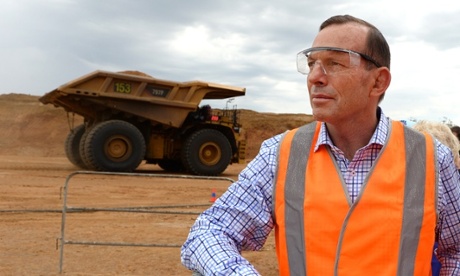
Carrington above provides a useful summary of the IPCC report. Jones identifies a change in approach:
- Instead of dealing largely in forecasts and responses, as in previous syntheses, it now frames the climate problem squarely in terms of risk management.
Jones then identifies some of the myths the report busts. Roz Pidcock at The Carbon Brief identifies what’s new and interesting about the report.
C. Forbes Tompkins and Kelly Levin at Climate Code Red list 9 significant scientific findings too recent to be included in the new IPCC report. Two of them relate to sea level rise, an increased fragility of both the Greenland and Antarctica ice sheets.
There are more links at the end of the post. I wish to comment on the appropriateness of the 2°C guardrail, the view of risk taken in relation to the 2°C and then some conclusions.
Is a 2°C temperature rise safe?
David Spratt addressed this issue in September 2013. To summarise some of what he said:
- The tipping point for Greenland Ice Sheet has been revised down to +1.6ºC (uncertainty range of +0.8 to +3.2ºC) above pre-industrial. We are likely to hit +1.6ºC within a decade or two.
- It has been shown that “preserving more than 10 per cent of coral reefs worldwide would require limiting warming to below +1.5°C (atmosphere–ocean general circulation models (AOGCMs) range: 1.3–1.8°C) relative to pre-industrial levels”.
- Large-scale thawing of permafrost may have already started, but a 1.5ºC global rise in temperature compared to pre-industrial should be enough to start a general permafrost melt.
- Current levels of CO2 at about 400 ppm place us in the Middle Pliocene epoch (3.0–3.5 Myr ago) when sea levels were 25m plus or minus 5 higher than now.
- During the Eemian 123,000 years ago sea-level rises of 3 metres occurred within 50 years due to the rapid melting of ice sheets, when the energy imbalance in the climate system was less than at present.
On sea level rise, here are the projections given in the Long Report p. 60:
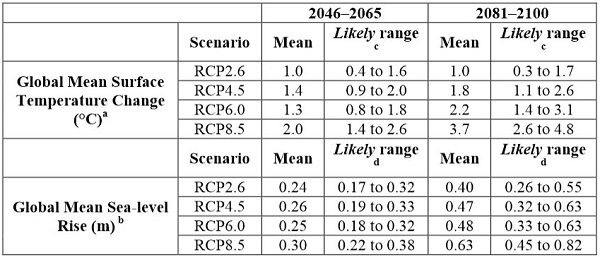
In a footnote we are told:
- Based on current understanding (from observations, physical understanding and modelling), only the collapse of marine-based sectors of the Antarctic ice sheet, if initiated, could cause global mean sea level to rise substantially above the likely range during the 21st century. There is medium confidence that this additional contribution would not exceed several tenths of a metre of sea-level rise during the 21st century.
They’ve covered themselves on Antarctica, but missed the fragility of Greenland. On page 30, they say this:
- There is low confidence in the available models’ ability to project solid ice discharge from the Antarctic ice sheet. Hence, these models likely underestimate the Antarctica ice sheet contribution, resulting in an underestimation of projected sea-level rise beyond 2100. (p30, Long report)
On sea level rise unfortunately for the next seven years we will be quoted the means given in the tables, without the qualifications, which themselves are inadequate in the late of the latest science. So the talk will be about half a metre, or up to a metre maximum.
For these and the other reasons quoted, plus a few I didn’t highlight, a 2°C guardrail looks foolhardy to say the least.
View of risk taken in relation to the 2°C
This table gives some overview of the relationship between the emissions levels, RCP scenarios, temperature change and the likelihood of staying below various temperature levels. I’ve actually taken the table from Working Group 3 and adapted it by taking out four columns (relating to quantums of CO2 and emissions reduction targets for 2050 and 2100) to highlight the broad relationships:
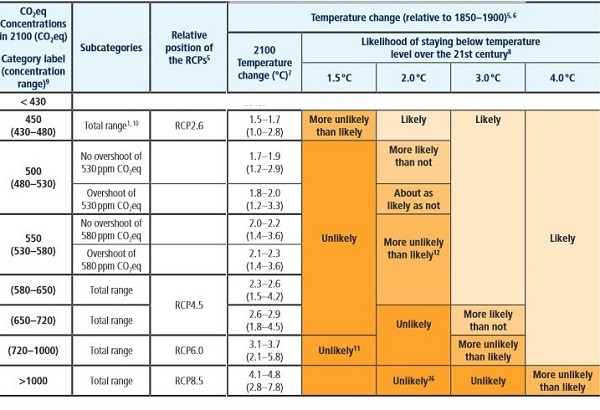
Much of the same information is given in the table on p23 (Short Report) and footnotes.
In the Short Report (p15) we are told that CO2e levels in 2011 were 430 ppm. Unfortunately the CSIRO/BOM State of the climate report says that in 2014 we are at 480 ppm of CO2 equivalent. So realistically the best on offer is the 500 zone with overshoot. This sees us with a likely as not chance of staying below 2°C. Here’s what the official language means:
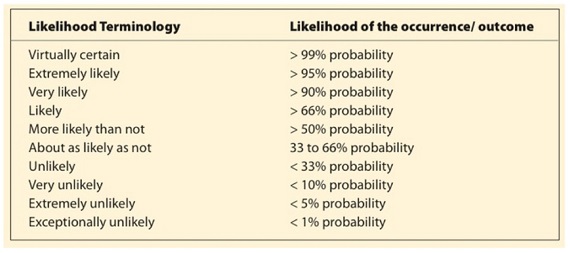
In other words a 33 to 66% chance of staying below 2°C, or if we act quickly and drastically a 66% chance. When you consider the implications even of a 1.5°C climate, this is desperately insane and simply not acceptable.
David Spratt suggests a risk-averse (pro-safety) approach, say, of less than 10% probability of whatever target we deem appropriate. I’d suggest a less than 5% probability of a 1.5°C temperature rise and then see whether that is doable. Are we game to talk about what really needs to be done for a livable, sustainable ecosystem for future generations? Or are we going to continue eating our children’s future?
Conclusions
Back in 2007 environmentalist Bill McKibbin asked James Hansen what the appropriate levels of CO2 should be. Hansen gave his answer in December 2007 at the American Geophysical Union meeting. At that very time the UNFCCC Conference of Parties was meeting in Bali. Hansen’s response was that we had overshot and that we should aim at 350 ppm by taking CO2 out of the atmosphere. To clarify, Hansen’s answer assumed that we would achieve net zero in other greenhouse gases, so he was really talking about CO2e. McKibbin went off and started up 350.org.
In a strict sense the IPCC Report is agnostic about a 2°C guardrail. It simply identifies risks, vulnerabilities and impacts at various temperature levels. However, when it comes to mitigation scenarios, it deals with what is out there in the scientific literature. Here it seems the vast bulk of the modelling contemplates scenarios where the 2°C guardrail is simply part of the furniture. Yet what has been called CCS (carbon capture and storage) and the report (see Short Report p.15 for example) re-badges as CDR (carbon dioxide removal) is also part of the furniture.
It seems to me that the scientific community is struggling to catch up with where Hansen was seven years ago. Perhaps they are concentrating on what’s doable, but at the same time they are holding out false hope. While the world’s scientists and governments have issued their bluntest warning yet, we seem to be letting go the idea of a safe climate. I heard head honcho Rajendra K Pachauri on the radio saying that we only had a budget of 275Gt of carbon (that’s about 1000GT of CO2) left that could be used. In fact, rationally, we don’t have a budget at all, we are in the red. Rationally, all the fossil fuel reserves should be left in the ground – all of them, unless offset with CCS or CDR, for which our visionary PM has just slashed the research budget.
Update:
Al Jazzeera rounds up some of the opinion warning that 2°C is foolhardy and dangerous.
- “There is no such thing as a safe rise,” said Bob Watson, who was the chair of the IPCC from 1997 to 2002. “You will see food and water insecurity, human health problems, and sea level rise even with a 2 C rise.”
And so on.
See also:
UN Climate Report Rings Alarm, Offers Guidance
World’s Scientists Warn: We Have ‘High Confidence’ In The ‘Irreversible Impacts’ Of Climate Inaction
Media round-up: The IPCC synthesis report
That last link from The Carbon Brief is quite comprehensive and includes a list of their six posts.
Related IPCC posts, in chronological order:
Crisis or catastrophe? What will the IPCC say?
A choice of catastrophes: the IPCC budget approach
Commentary on IPCC WG1: Part 1
Commentary on IPCC WG1: Part 2
Climate change impacts: IPCC Working Party 2 report
Adding to the muddle? The IPCC climate change mitigation report
Climate clippings 112
1. Will Australia be to world climate talks what Poland is to Europe?
That’s the question asked by Giles Parkinson.
On the international stage Australia plays a similar role to Poland in Europe. The two countries have much in common: their leaders share a tenuous hold on climate science, a grim determination to extract coal and use it for electricity, don’t like carbon pricing and are trying to keep a lid on renewables.
From what he says, there does seem a difference. Poland gained free carbon permits from the EU negotiations “worth more than $1 billion and promises for funds to help it “modernize” is coal-fired plants after 2020.”
Prime Minister Ewa Kopacz said after the summit that the threat of veto was simply a “tool” to get the best conditions for Poland’s economy. “Nobody got compensated like we did,” she boasted after the meeting.
In other words they were out for what they could get.
On the basis of the Abbott Government’s form in the UNFCCC Conference of Parties in Warsaw last December and actions since, we can expect Australia to be actively hostile to positive outcomes. Not just lead in the saddle bag, an active saboteur.
2. The prospect of a Republican US Senate
There is a 68% chance that the Republicans will control the US Senate after the mid-term elections. For the climate this could be a disaster.
Certainly they are unlikely to control the 60 votes they would need to avoid a Democrat filibuster, and the President has the power of veto over bills. So anti-climate legislation is not so much the worry.
However, the Republicans could block appropriate appointments to various agency positions and regulatory posts.
Secondly, any treaty coming out of the 2015 UNFCCC talks in Paris next year would need to be legislated. This would be impossible and could affect the tenor of the entire negotiations, with one large lame duck at the table.
Third, the US contributions to the IPCC and the UNFCCC could be pulled, making life for those bodies impossible.
Fourth,
a GOP majority in that house of Congress would flip several key committees into Republican hands. In particular, Sen. Jim Inhofe (R-OK) is up to take over the Environment and Public Works Committee, Sen. Ted Cruz (R-TX) would head the Subcommittee on Science and Space, Sen. Ron Johnson (R-WI) is in line to take control of the Homeland Security and Governmental Reform Committee, and Sen. Mike Enzi (R-WY) would head up the Budget Committee.
All except Enzi are avowed climate denialists.
Then there’s scary budget negotiations, and more.
3. Global groundwater crisis
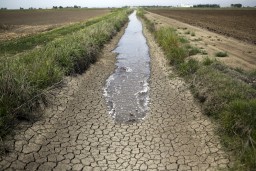
A NASA study has found that major groundwater aquifers are being depleted faster than the rate of replenishment, threatening food supplies and security.
The groundwater at some of the world’s largest aquifers — in the U.S. High Plains, California’s Central Valley, China, India, and elsewhere — is being pumped out “at far greater rates than it can be naturally replenished.”
The most worrisome fact: “nearly all of these underlie the word’s great agricultural regions and are primarily responsible for their high productivity.”
4. Geoff Cousins heads the ACF
You’ll probably recognise the gravel-voiced tones of Geoff Cousins from his campaign against the Gunns paper mill. He used 20,000 signatures from ANZ customers to pressure the bank to withdraw the project’s funds.
His business credentials include heading the country’s largest advertising company and heading Optus Vision when it slugged it out with News Ltd over rugby league broadcasting rights. He is a director of the Telstra board.
He is now President of the Australian Conservation Foundation, so expect to hear more from him. Now he’s lashed out at the Direct Action legislation and given the BCA (Business Council of Australia) a whack around the ears for supporting the legislation which he says individual companies would have rejected.
If somebody had brought a business case to the boards of one of those public companies for this program, no responsible board would have given it the time of day.
You would have asked first of all how cost efficient it was, you would have asked what was world’s best practice in all of these areas, these sorts of questions, and none of them would have been able to be answered positively in regard to this program.
The ACF are now embarking on a public education campaign about the legislation.
5. Food, Fossil Fuels and Filthy Finance
That’s the title of a report from Oxfam, summarised at Hot Topic.
On current trends, the world will be 4–6ºC hotter by the end of the century, exceeding 2ºC within the lifetimes of most people reading this report. This could put up to 400 million people in some of the poorest countries at risk of severe food and water shortages by the middle of the century.
This paper shows how, despite some steps in the right direction to tackle climate change, a ‘toxic triangle’ of political inertia, financial short-termism and vested fossil fuel interests is blocking the transition that is needed. To help break this, governments must commit to phase out fossil fuel emissions by early in the second half of this century, with rich countries leading the way.
In 2012 fossil fuel companies spent $674bn on exploration and development projects. The industry is supported by $1.9 trillion of subsidies public finance, incentives and tax breaks, including the costs of paying for its widespread damage.
Quite simply, most of the stuff should be left in the ground:

In truth, that’s generous!
PUP does a deal on Direct Action

If we didn’t know before, we know now that Clive Palmer will do a deal with the devil. He’s going to vote for a scheme that he comprehensively rubbished, said was a complete waste of money and he would never vote for it.
His price?
Clive Palmer won a Government commitment to salvage the Climate Change Authority and to ask it to conduct an 18-month review of the PUP plan to legislate an emissions trading scheme (ETS) at a zero rate.
This is of course a good thing. I understand that the Climate Change Authority will have something to say about targets before we have to make commitments in Paris next December. And the review can take into account Paris outcomes. The review and the work of the CCA may provide a road to redemption for the backsliders in the LNP. Bernie Fraser sees his task in this light, as he was quoted on PM:
What you’ve heard today is perhaps the beginning, the beginnings of an emerging broad, broader political consensus on climate change and the need to take effective action. Because that’s what this country needs more than anything else – the development of a broad political consensus.
Of course, the Government needs six votes from the cross bench.
Victorian senators Ricky Muir and John Madigan and South Australian senator Nick Xenophon have also given their vote to the Government after negotiations.
Xenephon was said to have won four out of five of his requirements. Included was his penalties for big emitters proposal.
To win the necessary support, the government has accepted a proposal by Senator Xenophon to put in place a “safeguard mechanism” to ensure companies comply with the scheme’s requirements.
Details of the safeguard mechanism will be mapped out later. Observers expect it to include some form of penalty for companies that fail to meet government-set benchmarks, although it remains uncertain what the penalties would be.
Uncertain too what the benchmarks will be.
Not included was Xenephon’s proposal to set aside $500 million to buy carbon offsets from abroad to ensure the target is met. No doubt that would be too much like carbon trading for the LNP to stomach.
Christine Milne slammed the direct action policy as “embarrassing”. She reminded us that Palmer helped the Government tear down the ETS. Here’s their Facebook entry.
Bill Shorten:
“Tony Abbott has once again sold his soul to Clive Palmer and Australia will pay the price,” he said.
“This is a dirty deal that will send our country backwards.”
The Climate Institute welcomed the preservation of the independent Climate Change Authority but wanted to see more details about the review.
“Moreover, we are deeply concerned that the amendments to the CFI Bill fail to establish a climate policy that gives a reasonable chance of achieving even the lowest level of Australia’s 5-25 per cent 2020 target range, let along the deeper decarbonisation of the economy that will be needed beyond 2020. The Climate Change Authority has recommended Australia adopt a 2030 emission reduction target of 40-60 per cent below 2000 levels.”
“Without access to international carbon permits, stronger domestic regulations will be needed to meet Australia’s emission goals. The ‘safeguard mechanisms’ in the legislation—the emission limits that companies will have to adhere to—will need to be very strong and get more stringent over time, and regulations to limit emissions and tighten energy efficiency standards across the economy will also be needed.”
Greg Jericho made the excellent point that the Abbott Government “has been extremely successful in making climate change policy more about electricity prices than about climate change.” Maybe Bernie Fraser and the CCA can gently nudge it in a different direction!
There’s more at The Conversation.
Update: Bret Harper and Hugh Grossman give the detail of the agreement on Direct Action. They include:
The government will also withdraw its Clean Energy Finance Corporation (Abolition) Bill 2014 and the Australian Renewable Energy Agency (Repeal) Bill 2014 during the Spring 2014 parliamentary sittings.
The CCA will produce three reports, going into targets for Copenhagen as well as emissions trading schemes.
Climate clippings 111
September followed August as record heat for the month worldwide. The period January-September was equal hottest with 1998 and 2010. The 12 months from October 2013 to September 2014 was the hottest 12-month period on record. The heat was just about everywhere, except for central Russia, some areas in eastern and northern Canada, and a small region in Namibia:
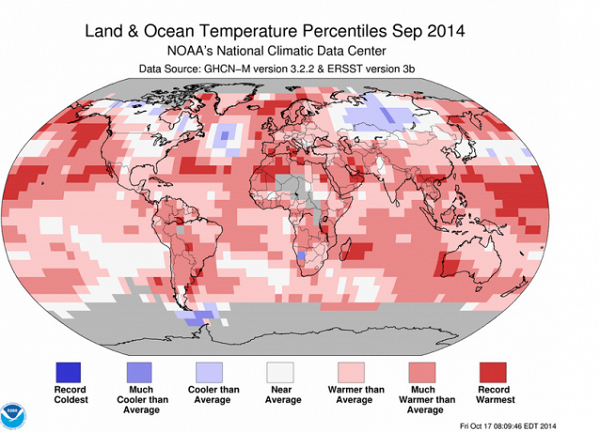
2. Coal is good for humanity!
Thus spake Tony Abbott, repeating lines imprinted on his mind by coal industry lobbyists.
In an important post Graham Readfearn tells how big coal is hijacking the energy poverty issue
telling the world that the only way the poorest nations can pull themselves out of poverty is by purchasing lots of their product.
The point that those same people will likely be hit earliest and hardest from the impacts of climate change being driven by that same product, is neatly swerved or underplayed.
So we have Peabody Energy “fueling the world with energy essential to sustain life”.
Pardon me while I have a quiet chunder!
3. New 2030 climate targets for the EU
On the whole climate campaigners are disappointed with the new emissions targets set by the EU – 40% reduction in emissions, 27% cut in energy use and 27% of energy must be from renewables.
The ETS is seen as essential in reaching these targets, so it will be reformed in an as yet undesignated way.
Rich countries like Germany, the UK and France will have to do better than the designated cuts to compensate for the continued reliance on coal by the likes of Poland, Bulgaria and Romania.
At Climate Progress it seems the American reaction is more favourable. They point out that the targets are the first substantive offer from any member of the international community ahead of the UN climate talks to be held in Paris in 2015. The Americans and the Chinese are unlikely to go so far.
Personally when they aim for net zero emissions by 2030 and aim for 350 CO2e ppm by 2050 I’ll say they are reconnecting politics with reality.
4. Arctic sea ice escalator
BilB drew attention to Skeptical Science’s Arctic sea ice escalator:
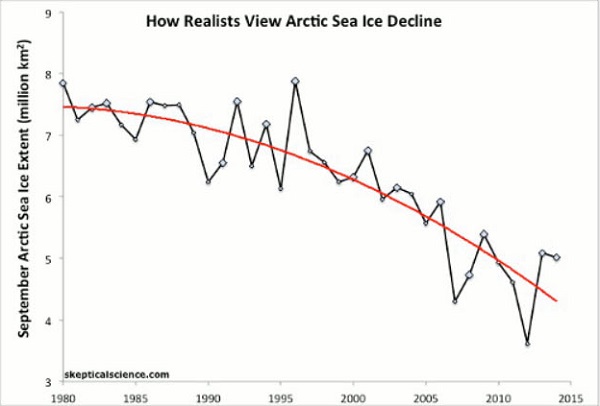
He’s right, the next break downwards could shock some doubters.
Perhaps enough to shake pollies of all stripes out of their torpor.
If you look at the trend from the late 1990s it looks even more dramatic.
The full article has two further graphs:
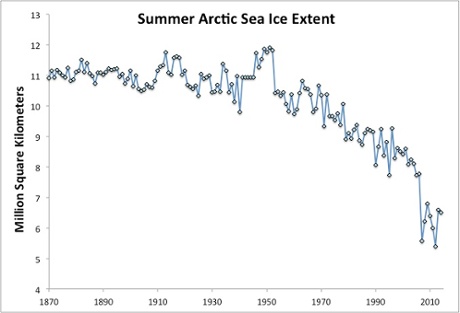
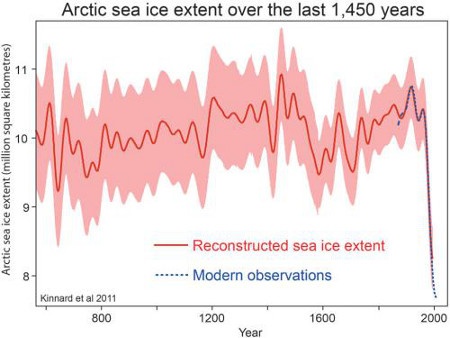
Actually there’s something wrong with both. The y axis should go below 4. It’s like where you have a graph on a wall and the line falls off the graph and onto the wall.
5. Pacific warriors blockade Newcastle
Climate Change Warriors from 12 Pacific Island nations paddled canoes into the world’s largest coal port in Newcastle, Australia, Friday to bring attention to their grave fears about the consequences of climate change on their home countries.
The 30 warriors joined a flotilla of hundreds of Australians in kayaks and on surfboards to delay eight of the 12 ships scheduled to pass through the port during the nine-hour blockade, which was organised with support from the U.S.-based environmental group 350.org.
The warriors came from 12 Pacific Island countries, including Fiji, Tuvalu, Tokelau, Micronesia, Vanuatu, The Solomon Islands, Tonga,
Samoa, Papua New Guinea and Niue.
6. Norway takes to electric cars
Norway, not a member of the EU, now has 15% electric cars. Since 2011 Nissan LEAF has become the nation’s third best-selling car.
Norway is not a member of the EU. It gets 98% of its power from renewables. Presumably it doesn’t go around preaching that oil is good for humanity!
7. How to build without bricks and cement
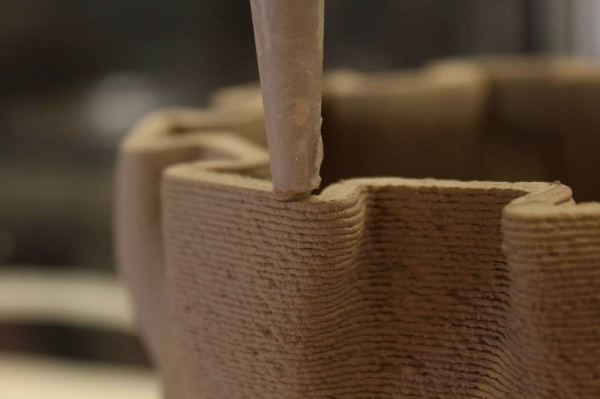
Thanks to John Davidson for those last two items.






